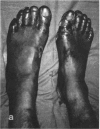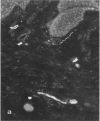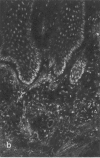Abstract
Non-freezing cold injury (trench foot) is characterized, in severe cases, by peripheral nerve damage and tissue necrosis. Controversy exists regarding the susceptibility of nerve fibre populations to injury as well as the mechanism of injury. Clinical and histological studies (n = 2) were conducted in a 40-year-old man with severe non-freezing cold injury in both feet. Clinical sensory tests, including two-point discrimination and pressure, vibration and thermal thresholds, indicated damage to large and small diameter nerves. On immunohistochemical assessment, terminal cutaneous nerve fibres within the plantar skin stained much less than in a normal control whereas staining to von Willebrand factor pointed to increased vascularity in all areas. The results indicate that all nerve populations (myelinated and unmyelinated) were damaged, possibly in a cycle of ischaemia and reperfusion.
Full text
PDF





Images in this article
Selected References
These references are in PubMed. This may not be the complete list of references from this article.
- Basbaum C. B. Induced hypothermia in peripheral nerve: electron microscopic and electrophysiological observations. J Neurocytol. 1973 Jun;2(2):171–187. doi: 10.1007/BF01474719. [DOI] [PubMed] [Google Scholar]
- Cocchia D., Michetti F., Donato R. Immunochemical and immuno-cytochemical localization of S-100 antigen in normal human skin. Nature. 1981 Nov 5;294(5836):85–87. doi: 10.1038/294085a0. [DOI] [PubMed] [Google Scholar]
- Cowen T., Haven A. J., Burnstock G. Pontamine sky blue: a counterstain for background autofluorescence in fluorescence and immunofluorescence histochemistry. Histochemistry. 1985;82(3):205–208. doi: 10.1007/BF00501396. [DOI] [PubMed] [Google Scholar]
- Das D. K., Iyengar J., Jones R. M., Lu D., Maity S. Protection from nonfreezing cold injury by quinacrine, a phospholipase inhibitor. Cryobiology. 1991 Apr;28(2):177–184. doi: 10.1016/0011-2240(91)90020-o. [DOI] [PubMed] [Google Scholar]
- Dellon A. L., Kallman C. H. Evaluation of functional sensation in the hand. J Hand Surg Am. 1983 Nov;8(6):865–870. doi: 10.1016/s0363-5023(83)80083-5. [DOI] [PubMed] [Google Scholar]
- Dellon A. L., Mackinnon S. E., Crosby P. M. Reliability of two-point discrimination measurements. J Hand Surg Am. 1987 Sep;12(5 Pt 1):693–696. doi: 10.1016/s0363-5023(87)80049-7. [DOI] [PubMed] [Google Scholar]
- Francis T. J. Non freezing cold injury: a historical review. J R Nav Med Serv. 1984 Winter;70(3):134–139. [PubMed] [Google Scholar]
- Fraser I. C., Loftus J. A. "Trench foot" caused by the cold. Br Med J. 1979 Feb 10;1(6160):414–414. doi: 10.1136/bmj.1.6160.414-b. [DOI] [PMC free article] [PubMed] [Google Scholar]
- Heimans J. J., Bertelsmann F. W., Van Rooy J. C. Large and small nerve fiber function in painful diabetic neuropathy. J Neurol Sci. 1986 Jun;74(1):1–9. doi: 10.1016/0022-510x(86)90186-3. [DOI] [PubMed] [Google Scholar]
- Irwin M. S. Nature and mechanism of peripheral nerve damage in an experimental model of non-freezing cold injury. Ann R Coll Surg Engl. 1996 Jul;78(4):372–379. [PMC free article] [PubMed] [Google Scholar]
- Kennett R. P., Gilliatt R. W. Nerve conduction studies in experimental non-freezing cold injury: II. Generalized nerve cooling by limb immersion. Muscle Nerve. 1991 Oct;14(10):960–967. doi: 10.1002/mus.880141006. [DOI] [PubMed] [Google Scholar]
- Kojo I., Pertovaara A. Effect of tourniquet-induced ischemia on cutaneous thermal thresholds. Acta Neurol Scand. 1986 Nov;74(5):383–386. doi: 10.1111/j.1600-0404.1986.tb03530.x. [DOI] [PubMed] [Google Scholar]
- Large A., Heinbecker P. Nerve Degeneration Following Prolonged Cooling of an Extremity. Ann Surg. 1944 Nov;120(5):742–749. doi: 10.1097/00000658-194411000-00006. [DOI] [PMC free article] [PubMed] [Google Scholar]
- Levy D., Abraham R., Reid G. A comparison of two methods for measuring thermal thresholds in diabetic neuropathy. J Neurol Neurosurg Psychiatry. 1989 Sep;52(9):1072–1077. doi: 10.1136/jnnp.52.9.1072. [DOI] [PMC free article] [PubMed] [Google Scholar]
- Murphy G. F., Bhan A. K., Sato S., Mihm M. C., Jr, Harrist T. J. A new immunologic marker for human Langerhans cells. N Engl J Med. 1981 Mar 26;304(13):791–792. doi: 10.1056/NEJM198103263041320. [DOI] [PubMed] [Google Scholar]
- Nukada H., Pollock M., Allpress S. Experimental cold injury to peripheral nerve. Brain. 1981 Dec;104(Pt 4):779–811. doi: 10.1093/brain/104.4.779. [DOI] [PubMed] [Google Scholar]
- Parsons S. L., Leach I. H., Charnley R. M. A case of bilateral trench foot. Injury. 1993 Dec;24(10):680–681. doi: 10.1016/0020-1383(93)90321-v. [DOI] [PubMed] [Google Scholar]
- Ramstead K. D., Hughes R. G., Webb A. J. Recent cases of trench foot. Postgrad Med J. 1980 Dec;56(662):879–883. doi: 10.1136/pgmj.56.662.879. [DOI] [PMC free article] [PubMed] [Google Scholar]
- Schaumburg H., Byck R., Herman R., Rosengart C. Peripheral nerve damage by cold. Arch Neurol. 1967 Jan;16(1):103–109. doi: 10.1001/archneur.1967.00470190107013. [DOI] [PubMed] [Google Scholar]
- Shahani B. T., Halperin J. J., Boulu P., Cohen J. Sympathetic skin response--a method of assessing unmyelinated axon dysfunction in peripheral neuropathies. J Neurol Neurosurg Psychiatry. 1984 May;47(5):536–542. doi: 10.1136/jnnp.47.5.536. [DOI] [PMC free article] [PubMed] [Google Scholar]
- Wrenn K. Immersion foot. A problem of the homeless in the 1990s. Arch Intern Med. 1991 Apr;151(4):785–788. doi: 10.1001/archinte.151.4.785. [DOI] [PubMed] [Google Scholar]








